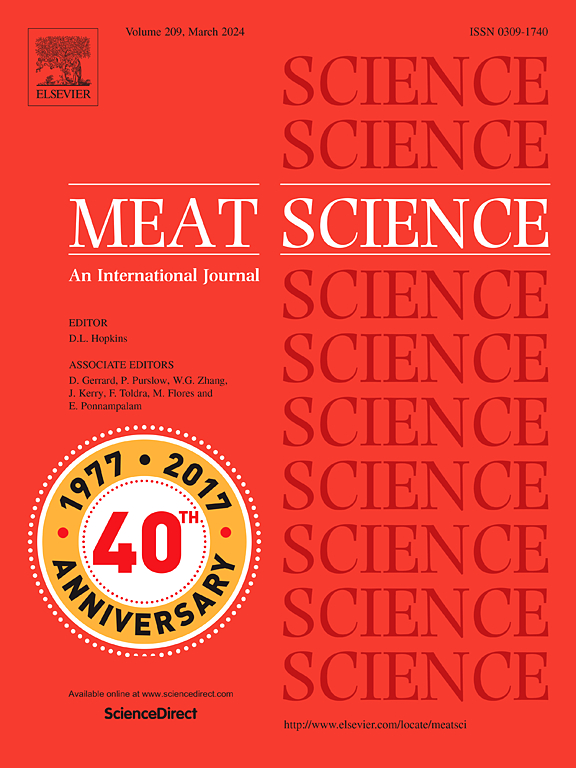Evaluation of portable, low-cost techniques for discriminating the DFD (dark, firm, dry) condition in beef
IF 6.1
1区 农林科学
Q1 Agricultural and Biological Sciences
引用次数: 0
Abstract
This study evaluated the effectiveness of portable, low-cost techniques, specifically colorimetry and visible spectroscopy for discriminating dark, firm, and dry (DFD) beef carcasses during processing in a certified slaughterhouse. Portable, low-cost devices were used for real-time assessments. A total of 523 chilled carcasses were analyzed, of which 449 were classified as normal and 74 as DFD, based on pH measurements (≥5.8 for DFD). Colorimetric variables (L*, a*, b*, chroma, and hue) were consistently higher in normal carcasses compared to DFD. Supervised classification models were used to predict DFD status using the evaluated detection techniques. Given the class imbalance, the Synthetic Minority Over-sampling Technique (SMOTE) was applied, significantly improving the performance of machine learning models. Portable spectroscopy showed superior performance, especially when combined with preprocessing techniques such as multiplicative scatter correction and second-order derivatives, achieving 96.77 % sensitivity and 98.06 % specificity with the Random Forest model. Although colorimetry proved effective, spectroscopy yielded greater reliability for real-time DFD detection. These findings highlight the potential of these techniques as cost-effective alternatives to traditional methods, supporting their applicability in rapid and objective meat quality assessments under industrial conditions.
评估便携式,低成本的技术,以区分DFD(暗,硬,干)状况的牛肉。
本研究评估了便携式、低成本技术的有效性,特别是比色法和可见光谱法在认证屠宰场加工过程中区分深色、硬硬和干(DFD)牛肉尸体。便携式、低成本设备用于实时评估。共分析了523具冷藏尸体,根据pH值(DFD≥5.8),其中449具被分类为正常,74具被分类为DFD。比色变量(L*、a*、b*、色度和色相)在正常胴体中始终高于DFD。利用评估后的检测技术,使用监督分类模型预测DFD状态。在类不平衡的情况下,采用了合成少数派过采样技术(SMOTE),显著提高了机器学习模型的性能。便携式光谱技术表现出优异的性能,特别是结合乘法散射校正和二阶导数等预处理技术,对随机森林模型的灵敏度达到96.77%,特异性达到98.06%。虽然比色法被证明是有效的,但光谱学在实时DFD检测中产生了更高的可靠性。这些发现突出了这些技术作为传统方法的成本效益替代品的潜力,支持了它们在工业条件下快速客观评估肉类质量的适用性。
本文章由计算机程序翻译,如有差异,请以英文原文为准。
求助全文
约1分钟内获得全文
求助全文
来源期刊

Meat Science
工程技术-食品科技
CiteScore
12.60
自引率
9.90%
发文量
282
审稿时长
60 days
期刊介绍:
The aim of Meat Science is to serve as a suitable platform for the dissemination of interdisciplinary and international knowledge on all factors influencing the properties of meat. While the journal primarily focuses on the flesh of mammals, contributions related to poultry will be considered if they enhance the overall understanding of the relationship between muscle nature and meat quality post mortem. Additionally, papers on large birds (e.g., emus, ostriches) as well as wild-captured mammals and crocodiles will be welcomed.
 求助内容:
求助内容: 应助结果提醒方式:
应助结果提醒方式:


